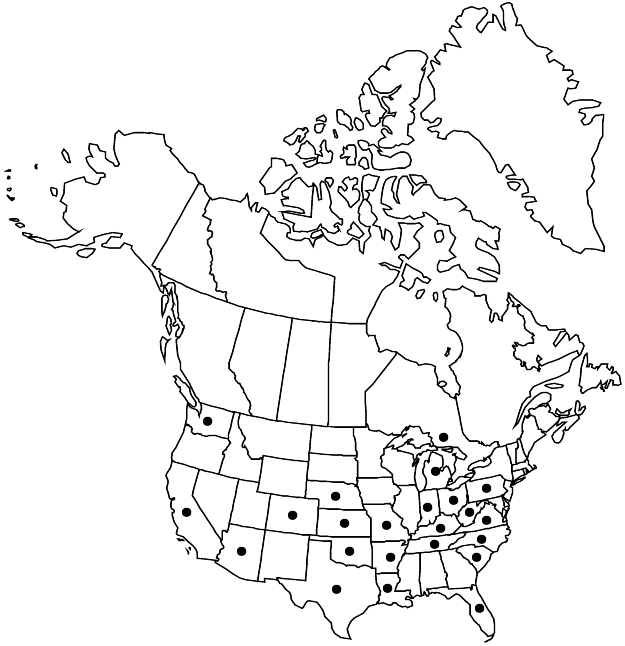Difference between revisions of "Stellaria pallida"
Man. Fl. Belgique ed. 2, 19. 1866.
FNA>Volume Importer |
imported>Volume Importer |
||
| (2 intermediate revisions by 2 users not shown) | |||
| Line 8: | Line 8: | ||
}} | }} | ||
|common_names=Lesser chickweed | |common_names=Lesser chickweed | ||
| + | |special_status={{Treatment/ID/Special_status | ||
| + | |code=I | ||
| + | |label=Introduced | ||
| + | }} | ||
|basionyms={{Treatment/ID/Basionym | |basionyms={{Treatment/ID/Basionym | ||
|name=Alsine pallida | |name=Alsine pallida | ||
| Line 38: | Line 42: | ||
|elevation=0-1500 m | |elevation=0-1500 m | ||
|distribution=Ont.;Ariz.;Ark.;Calif.;Colo.;Fla.;Ind.;Kans.;Ky.;La.;Mich.;Mo.;Nebr.;N.C.;Ohio;Okla.;Pa.;S.C.;Tenn.;Tex.;Va.;Wash.;W.Va.;Mexico;Europe. | |distribution=Ont.;Ariz.;Ark.;Calif.;Colo.;Fla.;Ind.;Kans.;Ky.;La.;Mich.;Mo.;Nebr.;N.C.;Ohio;Okla.;Pa.;S.C.;Tenn.;Tex.;Va.;Wash.;W.Va.;Mexico;Europe. | ||
| + | |introduced=true | ||
|discussion=<p><i>Stellaria pallida</i> is automatically self-pollinated and often cleistogamous. It usually can be distinguished from apetalous forms of <i>S. media</i> by its smaller size, yellowish green color, its small sepals and small, pale seeds. Also the base and tip of the sepals occasionally are dark-red pigmented.</p> | |discussion=<p><i>Stellaria pallida</i> is automatically self-pollinated and often cleistogamous. It usually can be distinguished from apetalous forms of <i>S. media</i> by its smaller size, yellowish green color, its small sepals and small, pale seeds. Also the base and tip of the sepals occasionally are dark-red pigmented.</p> | ||
|tables= | |tables= | ||
| Line 64: | Line 69: | ||
|publication title=Man. Fl. Belgique ed. | |publication title=Man. Fl. Belgique ed. | ||
|publication year=1866 | |publication year=1866 | ||
| − | |special status= | + | |special status=Introduced |
| − | |source xml=https:// | + | |source xml=https://bitbucket.org/aafc-mbb/fna-data-curation/src/2e0870ddd59836b60bcf96646a41e87ea5a5943a/coarse_grained_fna_xml/V5/V5_231.xml |
|subfamily=Caryophyllaceae subfam. Alsinoideae | |subfamily=Caryophyllaceae subfam. Alsinoideae | ||
|genus=Stellaria | |genus=Stellaria | ||
Latest revision as of 22:09, 5 November 2020
Plants annual, usually yellowish green, with slender taproot. Stems prostrate, much-branched, 4-sided, usually 10–20(–40) cm, glabrous, with single line of hairs along each internode. Leaves petiolate (proximal) or sessile (distal); blade ovate to elliptic, usually 0.3–1.5 cm × 1–7 mm, base round to cuneate, margins entire, apex shortly acuminate, glabrous or with few cilia on margins and abaxial midrib. Inflorescences terminal, 3–35-flowered cymes; bracts lanceolate, 2–10 mm, herbaceous, margins entire. Pedicels spreading, sometimes deflexed at base in fruit, 1–10 mm, pubescent. Flowers 2–3 mm diam.; sepals 4–5, veins obscure, midrib sometimes present, lanceolate, 3–4 mm, margins narrow, herbaceous, apex acute, pubescent; petals usually absent; stamens 1–3 or absent; anthers gray-violet; styles 3, ascending, becoming curled, 0.2–0.5 mm. Capsules pale straw colored, ovoid, 2–4(–5) mm, equaling to slightly longer than sepals, apex obtuse, opening by 6 valves, outwardly curled at tip; carpophore absent. Seeds pale yellowish brown, reniform to round, 0.5–0.9 mm diam., tuberculate; tubercles prominent, broader than tall, apex obtuse. 2n = 22.
Phenology: Flowering spring.
Habitat: Dunes, sandy waste places, rest areas on interstate highways
Elevation: 0-1500 m
Distribution

Introduced; Ont., Ariz., Ark., Calif., Colo., Fla., Ind., Kans., Ky., La., Mich., Mo., Nebr., N.C., Ohio, Okla., Pa., S.C., Tenn., Tex., Va., Wash., W.Va., Mexico, Europe.
Discussion
Stellaria pallida is automatically self-pollinated and often cleistogamous. It usually can be distinguished from apetalous forms of S. media by its smaller size, yellowish green color, its small sepals and small, pale seeds. Also the base and tip of the sepals occasionally are dark-red pigmented.